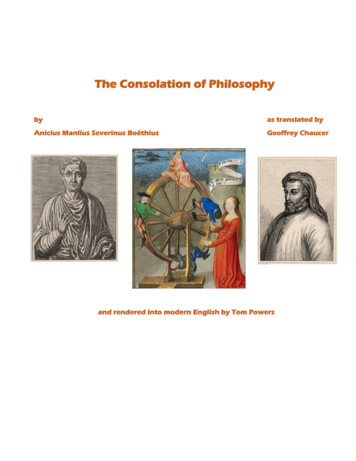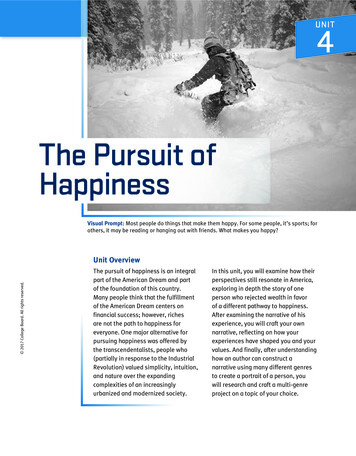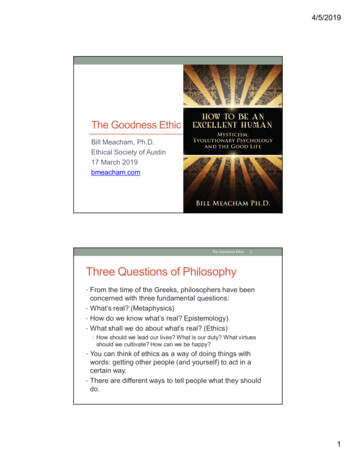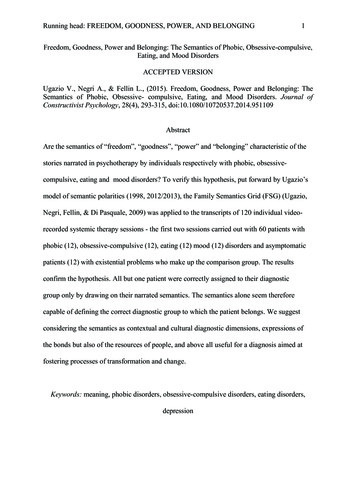
Transcription
Running head: FREEDOM, GOODNESS, POWER, AND BELONGING1Freedom, Goodness, Power and Belonging: The Semantics of Phobic, Obsessive-compulsive,Eating, and Mood DisordersACCEPTED VERSIONUgazio V., Negri A., & Fellin L., (2015). Freedom, Goodness, Power and Belonging: TheSemantics of Phobic, Obsessive- compulsive, Eating, and Mood Disorders. Journal ofConstructivist Psychology, 28(4), 293-315, doi:10.1080/10720537.2014.951109AbstractAre the semantics of “freedom”, “goodness”, “power” and “belonging” characteristic of thestories narrated in psychotherapy by individuals respectively with phobic, obsessivecompulsive, eating and mood disorders? To verify this hypothesis, put forward by Ugazio’smodel of semantic polarities (1998, 2012/2013), the Family Semantics Grid (FSG) (Ugazio,Negri, Fellin, & Di Pasquale, 2009) was applied to the transcripts of 120 individual videorecorded systemic therapy sessions - the first two sessions carried out with 60 patients withphobic (12), obsessive-compulsive (12), eating (12) mood (12) disorders and asymptomaticpatients (12) with existential problems who make up the comparison group. The resultsconfirm the hypothesis. All but one patient were correctly assigned to their diagnosticgroup only by drawing on their narrated semantics. The semantics alone seem thereforecapable of defining the correct diagnostic group to which the patient belongs. We suggestconsidering the semantics as contextual and cultural diagnostic dimensions, expressions ofthe bonds but also of the resources of people, and above all useful for a diagnosis aimed atfostering processes of transformation and change.Keywords: meaning, phobic disorders, obsessive-compulsive disorders, eating disorders,depression
Running head: FREEDOM, GOODNESS, POWER, AND BELONGING2Freedom, Goodness, Power and Belonging: The Semantics of Phobic, Obsessivecompulsive, Eating, and Mood DisordersAn idea in search of dataThe idea that the main psychopathologies are characterized by specific meanings,formulated for the first time by Guidano (Guidano, 1987, 1991; Guidano & Liotti, 1983),forms the basis of Ugazio’s psychopathological model (1998, 2012/2013). Guidano and thoseinspired by his model focus attention on individual processes through which personalmeaning is constructed. Ugazio, as Procter (1981, 1996, 2005), shifted attention ontoconversational processes in the family and other social groups through which individualsbuild meaning, and therefore themselves and the worlds in which they belong. Theproposition put forward is that people with a phobic, obsessive-compulsive, eating and mooddisorder are members of families in which the conversation is dominated by specificmeanings. It is suggested that four different configurations of meaning characterize theconversational contexts within which phobic, obsessive-compulsive, eating and mooddisorders respectively develop: These are the semantics of “freedom”, of “goodness”, of“power” and of “belonging”. Ugazio et al. (2009) have called these coherent sets of meanings“family semantics” because they come from the same emotional polarities, which typicallyoriginate within primary social contexts like families. In family contexts in which, forexample, we find people with phobic disorders, the semantic of freedom would prevail,fuelled by the emotive polarity “fear-courage”. By virtue of the relevance of this semantic,the conversation in these families tends to be organized around episodes where fear, courage,the need for protection and the desire for exploration and independence play a central role. In
Running head: FREEDOM, GOODNESS, POWER, AND BELONGING3families where obsessive-compulsive disorders are present, the semantic of goodness woulddominate, whose driving-force is guilt and purity, and in those where we find people witheating disorders or chronic depression, the conversation would tend to give central place,respectively, to the semantics of power and belonging which, as we shall see, are fuelled byother emotive polarities.The prevalence of these semantics in the family conversation is not enough in itself tofavor the development of the related psychopathology. A family conversation can, forexample, be dominated by the semantic of freedom without any member of the familydeveloping a phobic disorder. But the eventual appearance of one of the psychopathologiesmentioned is, according to Ugazio, favored by the reciprocal positioning assumed by thepatient and their relatives in the conversation within the dominant family semantic. It can infact happen that a member of the family, by reason of their very position within the semanticof freedom, experiences a conflictual situation definable as a “dilemma” (Feixas & Saúl,2005) or a “strange reflexive loop” (Cronen, Johnson, & Lannamann, 1982) that can trigger afull-blown psychopathological disorder. According to Ugazio’s model, it is therefore theposition more than the semantic that plays a central role in the transition from normality topsychopathology.The proposition put forward has been confirmed by studies carried out on onepsychopathology alone or two maximum. 1 There is a lack of empirical studies to test thishypothesis where there is a joint presence of patients with a phobic, obsessive-compulsive,mood and eating disorders. This is what we have sought to do in this study. Before describingit, we will briefly illustrate below the four semantics we intend to investigate.See Castiglioni, Faccio, Veronese, and Bell (2013); Castiglioni, Veronese, Pepe, and Villegas (2014); Faccio,Belloni and Castelnuovo (2012); Negri, Zanaboni, and Fellin (2007); and Ugazio, Negri, Zanaboni, and Fellin(2007).1
Running head: FREEDOM, GOODNESS, POWER, AND BELONGING4The semantic of freedomIn conversational contexts in which this semantic prevails, courage and fear dominatethe emotive scene. The world is seen—often as a result of dramatic events in a more or lessdistant past—as a source of risk to health, to relationships and to the very survival of theindividual. Even emotions, for the abrupt way in which they arise, can be perceived asthreatening. The exploration of the outside world, but also of personal feelings and states ofmind, is perceived as hazardous. Attachment to others, on the other hand, is a source ofprotection. Those who free themselves from the reassuring presence of protectiverelationships are considered courageous for the very reason that the real world arouses fear.Exploration often generates disorientation and can consequently lead members of thesefamilies to seek a closeness to each other that is seen as protective but also limiting. Being ina close relationship can therefore generate feelings of constriction, whereas moving awayfrom protective ties can produce a sense of disorientation.Freedom- dependence and exploration-attachment are the central polar meanings of thissemantic. Freedom and exploration are experienced as positive values, whereas the bonds ofattachment, the company of the other persons, are felt as an expression of the need forprotection from a dangerous world. Love, friendship and every other relationship ofattachment are consequently equated with forms of dependence, and therefore evaluated inpartially negative terms. On the other hand, dealing with circumstances alone increases selfesteem, since it expresses courage.As a result of these conversational processes members of these families will feel, orbe defined as, fearful or cautious or, alternatively, courageous, even reckless. Theywill find people who are prepared to protect them or will meet up with people whoare unable to survive by themselves, who need their support. They will marrypeople who are fragile or dependent, but also individuals who are free and
Running head: FREEDOM, GOODNESS, POWER, AND BELONGING5sometimes unwilling to make commitments. They will suffer for their dependence.They will try in every way to gain their independence. In other cases they will beproud of their independence and freedom, which they will defend more thaneverything else. Admiration, contempt, conflict, alliances, love and hatred will beplayed out around issues of freedom-dependence. ( )In the same family we will therefore have globetrotters as well as people who havenever moved away from the area where they were born. And there will be those like agoraphobic patients -who are so dependent and in need of protection that theywill require someone to be with them to deal with the most ordinary situations indaily life, and those who, on the other hand, will be so independent as to seem selfsufficient. (Ugazio, 2013, p.84)Interpersonal relationships are constructed within this semantic mainly through movingcloser or further apart: regulating distances is a central theme where this semantic dominates.Closeness to the other is indispensable, because the individual often feels at the edge of adangerous precipice, but it generates feelings of constriction that push the person to movephysically away from others or to withdraw. When the individual senses danger or a personalfragility he moves closer to others to look for support; on the other hand, when he feelsstrong, he moves away, frees himself from others so as to explore.Ugazio (1998, 2012/2013) has suggested that this semantic is present in theconversational context of individuals with a phobic disorder.The semantic of goodnessInnocence-guilt and disgust-sensual pleasure are the emotions underlying this familysemantic in which personal ambition and sexuality are perceived as violent, immoral orperverse. Their expression can therefore lead some members to experience guilt and disgust,
Running head: FREEDOM, GOODNESS, POWER, AND BELONGING6while in others it produces pleasure. Sacrifice and self-denial, on the other hand, areassociated with purity and innocence.The central meanings can be summarized in the polar opposites good-bad and deadalive. The second gives a dramatic pathos to this semantic, insofar as life stands on the side ofbadness. Bad people pursue their own pleasure and personal fulfillment, whereas good peopledisregard their personal desires, objectives and ambitions, they make sacrifices, they take astep back from life instead of acting or doing their best for the good of themselves and ofothers. As a result of this ‘abstinent’ 2 conception of goodness, the chastity-vice polarityperhaps most faithfully expresses the central meaning of this semantic, but it would end upestablishing a connection with sexuality that is not always present nowadays.When this semantic prevails, the conversation in the familyis organized preferably around episodes which bring into play the deliberateintention to do harm, selfishness, greed, guilty pleasure, but also goodness, purity,innocence, asceticism, as well as sacrifice and abstinence. As a result, members ofthese families will feel, and be seen as, good, pure, responsible or alternatively bad,selfish, immoral. They will meet people who will save them, improve them, or, onthe contrary, who will initiate them into vice, lead them to behavior that will thenmake them feel guilty. They will marry people who are innocent, pure, capable ofself-denial or, on the other hand, cruel egoists who will take advantage of them.Their children will be good, pure, chaste or alternatively will express their feelingswithout restraint, be aggressive in affirming themselves and their sexuality. Some of2The adjective ‘abstinent’ defines a specific construction of goodness as noluntas (Schopenhauer,1819/1969). In many Western cultures, the “self-denial/self-assertion” polarity does not convey a predefinedmoral order, but here self-denial and (abstemious) goodness express the positive pole by representing a step backfrom life, whereas self-assertion and badness qualify negative, although lively, habits (voluntas in Schopenhauer’sterms).
Running head: FREEDOM, GOODNESS, POWER, AND BELONGING7them will suffer for the selfishness and malice of others, or for the intrinsic badnessof their own impulses. Others will be proud of their own purity and moralsuperiority. And some will feel gratified by the satisfaction of their own impulses.There will be those, especially in families where this polarity dominates theconversation over several generations, who have so proven their particular selfdenial as to seem ascetic, and those who have expressed their impulses with suchselfishness as to be considered evil. (Ugazio, 2013, p. 129)Abstaining-becoming corrupt and self-sacrificing-taking advantage are the two mainrelational alternatives available to those who experience contexts characterized by thissemantic. The first polarity makes direct reference to the sexual dynamics; nonetheless everyinvolvement in the relationship (even if sex plays no part) is perceived as a vehicle thatcorrupts personal moral integrity which, however, is preserved by abstinence and self-denial.Becoming corrupted and taking advantage of others is the negative pole of the secondpolarity, in that they create an exchange with the others in which personal interest and theachievement of personal pleasure prevail; on the other hand, those who position themselvesin the opposite pole, which is generally regarded as positive, sacrifice their personal needsand their personal success.According to Ugazio (1998, 2012/2013), this semantic prevails in the conversationalcontexts of those who develop an obsessive-compulsive disorder or personality.The semantic of powerPride and shame are the basic emotions in this semantic. They are emotions generatedby the perception of personal social status, inside and outside the family, and the recognitiongiven to personal position in competitive conflicts, which are always central in relationalcontexts in which this semantic is prominent. Those who feel they are in a superior positionexperience feelings of personal capability and competence, while those who regard
Running head: FREEDOM, GOODNESS, POWER, AND BELONGING8themselves as being in a lower hierarchical position have a sense of inadequacy, ineptitudeand impotence. The scene is dominated by pride when personal superiority is recognized byother conversational partners or, alternatively, by shame or embarrassment when there is afeeling of defeat.Winner-loser and strong-willed/yielding are the two central polarities. The second polaropposition is subordinate to the first under a means-end relationship: those who win do soprecisely because they are strong-willed and determined while those who lose are incapableof asserting themselves. Winner-loser has a peculiarity that distinguishes it from all otherpolarities:its content is purely relational. People can only regard themselves as winners andlosers in comparison to others . [It] cannot be perceived, even during the course ofimmediate experiencing, in terms of an individual trait. It relates exclusively to therelationship. It is the result of a comparison. (Ugazio, 2013, p.182)Significant people and their evaluations are consequently perceived by members of thesefamilies, in every moment and every circumstance, as central for the definition of their ownself. This semantic generates a particular sensitivity to the judgment of others and criteria ofsocial success, including the precepts of external beauty.Since identities are defined through confrontation, competitive conflicts are the rule incouple and peer relationships. The object of contention is generally irrelevant; what matters iswho gains the upper hand. The predominance of competition obstructs the process ofexternalization of individual characteristics: Differences are feared because they are notutilized for cooperation but for affirming personal superiority. Every difference is alwaysdrawn in reference to status: Those who are self-important are so in relation to theirhierarchical position, those who are humble are so because they do not give themselves airs
Running head: FREEDOM, GOODNESS, POWER, AND BELONGING9despite their status, they feel humiliated because they are treated as belonging to an inferiorclass. The body is a prime place for comparison: there are those who are more beautiful andthinner and those who are uglier and fatter. Thinness and beauty are values within thissemantic, not just because they are qualities that are socially admired in many westernizedcultures, but because they are a symbol of the individual’s determination. Those who cankeep their instincts at bay will also be quite tenacious in fighting to keep their personal powerin the relationship. On the other hand, those who give in to their needs will be much easierprey to being bullied by others.Winning or losing in the relationship is crucial in contexts in which this semantic iscentral. In order to win, people may fall into line with those who hold a higher position so asto gain advantage from it or they may fight them to keep their own position of supremacy orundermine them. Those who do not think they can improve their own position may yield andback away from confrontation, or they may set themselves against the winners, seeking atleast to delegitimize their superiority.The semantic of power, according to Ugazio (1998, 2012/2013), is a characteristic ofthose families in which one or more members present an eating disorder.The semantic of belongingThe emotions that permeate the experience of members of families in which thissemantic is prominent are joy-cheerfulness, despair-anger. Joy-cheerfulness are experiencedby those who feel accepted in the group to which they belong, whereas despair-anger affectthose who are excluded, abandoned or cheated out of a belonging to which they feel entitled.Anger makes people active and reactive, whereas despair makes them helpless against amisery that cannot be avoided. Those who are accepted feel gratitude, whereas members ofthe group who are excluded, or are offered a form of inclusion that is seen to be a threat totheir own dignity, feel resentment.
Running head: FREEDOM, GOODNESS, POWER, AND BELONGING10Inclusion-exclusion, honor-shame are the main dimensions along which conversation isdeveloped in relational contexts where this semantic is prominent. Inclusion in the family,among relatives, the same stock, in the community or, alternatively, exclusion or ostracismfrom the group, are the background against which identities are structured. Those in theposition of being excluded experience their expulsion from the group as a disgrace, anirreparable damage that harms their dignity, a subversion of a natural order that damages theirpersonal sense of worth. Inclusion is felt to be an honor for which those members who takepart in the conversation may or may not be worthy. Though they crave for belonging, somemembers can refuse it in the name of dignity: in certain circumstances, acceptance to beingincluded can lead to a shame that is even worse that rejection itself.In this semantic, moreover, belonging is not won by personal commitment but pertainsto the individual through birth or election. Glory, like honor and dignity, cannot be directlylinked to belonging: the person excluded and rejected has the possibility of preserving honorand dignity and even achieving glory. Certainly,when the semantic of belonging has a long history in a family, extending back overseveral generations, those who are black sheep, or have been disowned, defraudedor forgotten co-position themselves with individuals who are respected, or worthyof being remembered for their actions, or have simply been included by divine graceamong the elect. Illegitimate births, desertions, abandonments are matched withfortunate events such as inheritances, fairytale weddings, professional honors,dazzling careers. Life for some seems to have been harsh, while for others it hasbeen particularly kind. Some members of the family are adored and admired whileothers are ignored or become the object of aggression and violence”. (Ugazio, 2013,pp. 232–233)
Running head: FREEDOM, GOODNESS, POWER, AND BELONGING11Including oneself or others in one’s own family or community or, on the contrary,excluding oneself or others are the characteristic and central ways of relating in this semantic.Sharing in all its forms is always desired, even though people who have grown up in contextswhere this semantic dominates often isolate themselves. Equally central are honoring,adoring or being adored, as are dishonoring, shaming or cheating. Partners who positionthemselves in conversations created by this semantic can be lavished with every kindness,praised, celebrated, but also cheated out of a position of belonging to which they are entitled,in the same way that they can fraudulently appropriate a name, a reputation, a status.Ugazio (2013) has suggested that this semantic is characteristically dominant inconversational contexts where one or more individuals are prone to mood disorders. In actualfact, depression is present as a symptom in almost all the main psychopathologicalorganizations.Anorexics are unlikely to suffer from it, but many obese people do. Phobic patientscan also display depressive disorders, especially agoraphobics whose self-esteem isstructurally low since they suffer through their dependence. Depression isparticularly frequent among obsessives. The main reason that brings people withnarcissistic disorder into therapy is depression (Ugazio, p.228).In addition to these inherent nosographic difficulties are many others caused bythe DSM’s particularly unsatisfactory criteria for diagnosing depression (Wakefield, 2012).The label of major depression continues to be so broad in the fifth edition of the Diagnosticand Statistical Manual of Mental Disorders (American Psychiatric Association [APA], 2013)as to be undiscriminating. Included in it are people who are sad as a result of negative eventsin their life just as much as patients affected by actual unipolar depression, and sub-type IIbipolar disorders is such as to include unipolar depressions. The semantic of belongingcharacterizes only some forms of depression, especially those nosographically defined as
Running head: FREEDOM, GOODNESS, POWER, AND BELONGING12chronic depression and sub-type II bipolar disorders. It helps to identify them and todifferentiate them from the depressions we can frequently find within the semantic ofgoodness and, sometimes, in the semantics of freedom and power.HypothesesThe specific hypotheses that this study seeks to test can be summarized in the form offour questions.1. Is each of the four semantics described above present in the therapy conversationwith the patients for whom it is considered to be characteristic (the target group)more than it is in the conversation with other patients (the non target groups)?It is expected here that the semantic of freedom is more present in theconversation with phobic patients than with those who have obsessivecompulsive, eating or mood disorders, or with clients free of full-blownpathologies. The same trend ought to characterize the therapy conversation withpatients who have obsessive-compulsive, eating or mood disorders, where it isexpected that the semantics of goodness, power or belonging will respectivelyprevail;2. In the conversation with patients belonging to each of the four psychopathologies– irrespective of the comparison with patients of another psychopathology -doesthe critical semantic 3 prevail over all other semantics?It is expected that the semantic of freedom in the conversation with phobicpatients is more present than the semantics of goodness, of power and of3By the expression “critical semantic” we mean the semantic considered by Ugazio (1998, 2012/2013) to becharacteristic of a specific psychopathological organization.
Running head: FREEDOM, GOODNESS, POWER, AND BELONGING13belonging. The other three critical semantics ought to prevail in the therapyconversation with patients who present the other three psychopathologies underconsideration;3. Who is mainly responsible for the prevalence of the critical semantic in thetherapeutic conversation? The patient or the therapist?The responsibility ought to fall mainly on the patient. In particular, we expect that:a. the majority of characteristic meanings of the critical semantic are introducedby the patient;b. the therapist tends to introduce more meanings extraneous to the four criticalsemantics (classified by our code system as other semantics) than the patientdoes.MethodParticipantsThe study was carried out on the first two psychotherapy sessions conducted by the firstauthor with 60 participants, aged between 17 and 59 (M 35.2; DS 9.5), of medium to higheducational and socio-economic level, equally distributed into five groups. Four groups areformed by patients affected by the psychopathologies that are at the core of this study andone, for comparison, by patients who have requested psychotherapy for a wide variety ofexistential problems (conflicts with partner and/or children, sudden bereavement, workproblems, relationship crises, etc.). Those taking part in the clinical groups present apsychopathology that respects the criteria of the DSM-IV-TR 4 (APA, 2000) whereas none of4The DSM-5 had not yet been published when the study was carried out.
Running head: FREEDOM, GOODNESS, POWER, AND BELONGING14the patients in the control group presents symptoms or satisfies the criteria for inclusion in adiagnostic category.We adopted a purposive sampling approach to the selection of the participants from anarchive of over 600 individual systemic consultancies and psychotherapies, all videorecorded and carried out at the European Institute of Systemic-relational Therapies (EIST), aprivate institute based in Milan, Italy and recognized by the Italian Ministry of Education andResearch. Firstly, all the cases archived with the diagnosis of one of the four targetpsychopathologies were extracted. Drawing especially on sessions 3 to 5—where symptomsare explored in more in-depth and in detail —the second and the third authors then excludedthose with comorbidities or non-prototypical symptoms: Those chosen for each diagnosticgroup were patients who had no other disorders and for whom there seemed no possibledoubt about diagnosis. Participants in the four clinical groups are therefore prototypicalpatients 5.ProcedureOnce the first two video recorded sessions (N 120) had been transcribed verbatim,following the appropriate indications (Mergenthaler & Stinson, 1992), we coded the semanticoppositions in the middle third of the transcribed sessions, lasting an average of 26 minutes.The coding was carried out by five researchers independently. To check the coders’reliability, a second independent coding was carried out on 36 transcripts. Twenty-eight ofthese were equally distributed between the four clinical groups and the remaining eightbelonging to the comparison group: 24 are first sessions, 12 are second sessions.5Forty-five cases of this sample were already included in three previous papers, one of these published in English(Ugazio, Negri, & Fellin, 2009) and 15 are new. We eliminated five cases from the 50 of 2009 sample for tworeasons: They were cases (2) treated many years ago (before 2000) or individual therapies preceded by couplesconsultation (3). So our current sample is more homogeneous than the previous one. The 2009 article presentsonly the reliability results of our coding tool (FSG). All the analyses, we will presented here, are new.
Running head: FREEDOM, GOODNESS, POWER, AND BELONGING15We chose to focus the study on the first two sessions since the influence of the therapiston the construction of patient meanings is less than in the later stages of the therapeuticprocess. The purpose of the first two sessions is in fact to understand and define the problembrought by the patient, to explore his or her current relational situation and the family history,and negotiate the effective possibilities of the treatment and its format (individual, coupleand/or family sessions).The analysis is restricted to the middle third of each session because the codingprocedures applied are very time-consuming and the duration of the sessions varies from 60to 90 minutes (M 78 min). We feel that the central third best represents the meanings of thepatient, since it is the phase that concentrates most on the patient’s story. The beginning ofthe first session is devoted to explaining the setting, introducing those taking part, filling outforms about the use of personal information, and then completing the information onindividual and family history which has already been partially gathered by telephone contactbefore the meeting. At the end of the second meeting the therapist—who previously confinesherself to questioning—intervenes: She summarizes what has emerged, often gives an initialassessment and discusses a possible beginning of therapy. The end of the second sessiongenerally marks the end of the consultation phase and, if the circumstances are right, thetherapy begins or the consultation is extended.CodingThe Family Semantics Grid (FSG) has been applied to the transcripts: This is a systemthat makes it possible to code the semantic polarities present in dyadic therapy conversations(Ugazio et al., 2009). The FSG provides a working definition of the conceptsof family semantic polarities and family semantics, a detailed description of the semanticpolarities making up the four proposed family semantics connected to the psychopathologies
Running head: FREEDOM, GOODNESS, POWER, AND BELONGING16under consideration, and a standardized procedure for detecting and coding these polarities inthe transcripts.The family semantic polarities are operationalized in the FSG as semantic oppositionsthrough which the patient and therapist position themselves within the following areas of theconversation: a) values; b) definitions of self/others/relationships; c) ways of relating; d)emotions. 6 These positionings can be
Freedom, Goodness, Power and Belonging: The Semantics of Phobic, Obsessive-compulsive, . phobic (12), obsessive-compulsive (12), eating (12) mood (12) disorders and asymptomatic . obsessive-compulsive, eating and mood disorder are members of fa

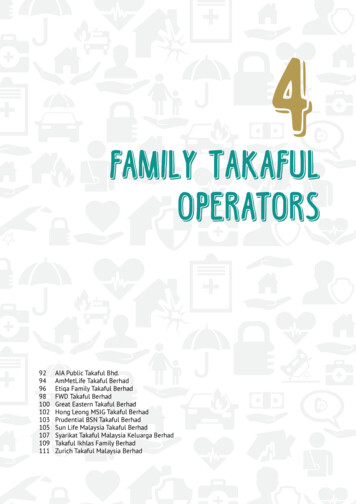
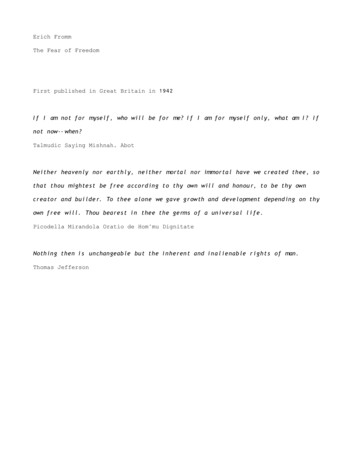
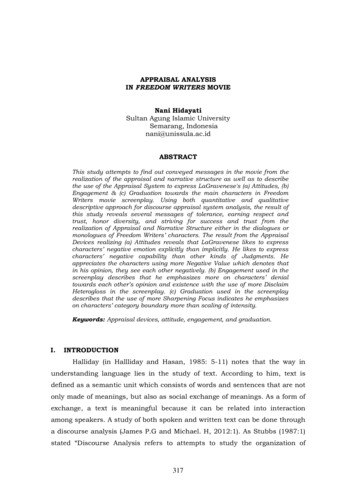
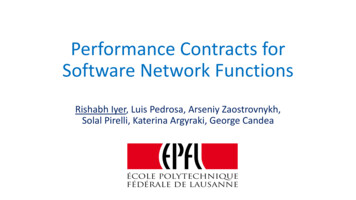

![Drawing the Human Head Burne Hogarth[English] - Internet Archive](/img/29/drawing-the-human-head-burne-hogarth-english.jpg)
